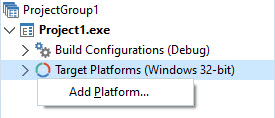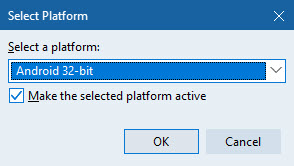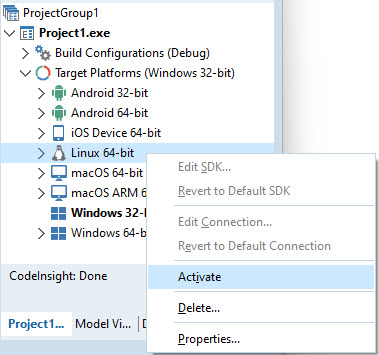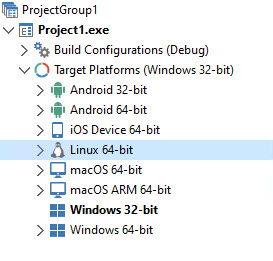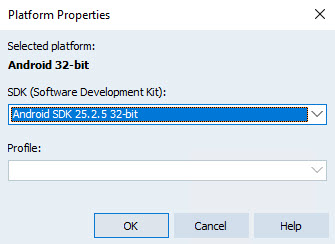Activating and Configuring the Target Platform
Go Up to Steps in Creating Multi-Device Applications
Before you can start writing the application code for a multi-device application, you need to create and configure your application in the Projects Window. You should have already performed the previous required steps in creating a multi-device application.
Summary
Before configuring your multi-device application in the Project Manager:
- If your application targets macOS or iOS, start by installing and running the Platform Assistant server on the Mac, and creating a connection profile that describes how to connect to that instance of the Platform Assistant server.
Then perform the following steps to configure a multi-device application (the steps are described in more detail in this topic):
- Create a project that is potentially multi-device.
- Add the target platform you want to use (using the Project Manager).
- Activate the target platform for the specific project.
- Configure the target platform.
Contents
Create a Multi-Device Application
Create one of the following project types, which are either potentially multi-device or multi-device by definition:
- Console application — for any supported platform
- File > New > Other > Delphi > Console Application
- Multi-Device Application — for any supported platform
- Windows VCL Application — for the 64-bit Windows platform
Nevertheless, to do remote debugging between the Win64 host PC and a remote PC (either Win32 or Win64), you can use the new debugging scheme, based on the Platform Assistant (required for multi-device application development). If you use the Platform Assistant and a connection profile for any application, including a Win32 application, you can also deploy your application using the Deployment Manager, which requires the Platform Assistant. For more information, see Debugging Multi-Device Applications.
Add a Target Platform
The Target Platforms node in the Projects Window displays the available platforms. However, when you create a project, some supported platforms might not be initially displayed. To create an application that targets a platform that is not currently displayed in the Target Platforms node, add the specific target platform you want, as follows:
1. Right-click the Target Platforms node in the Project Manager:
2. Click Add Platform on the context menu. The Select Platform dialog box appears:
3. Click the down-arrow and select a target platform from the list of supported platforms:

- Note: If you leave the Make the selected platform active checkbox enabled, the platform is automatically activated as it is added to your project, making the new platform the current target platform for your project. The name of the active platform appears in boldface in the Target Platforms node of the Project Manager. If you have previously associated a default connection profile or SDK with the platform you are adding, the name of the profile and the SDK is appended to the platform name in the Project Manager.
4. Click OK. If you want to add another target platform, repeat the previous steps and add another platform.
Activate a Target Platform
To specify that your application is to be multi-device, you must activate the desired target platform in the Projects Window. The activated target platform is shown in boldface in the Project Manager. The platform you activate determines the compiler and the tooling that your application uses (for example, Android 32-bit applications use the BCCAARM.exe and DCCAARM.exe compilers, and use FireMonkey and the FireMonkey-RTL).
To activate a target platform for your project
Do either of the following:
- Click the platform and the device in the Platform Device Selection Toolbar
- In the Target Platforms node on the Projects Window, double-click the target platform for your application.
- Right-click the Target Platforms node, and select Activate on the context menu:
The image below shows the Target Platforms node populated with the available desktop and mobile platforms (Linux requires Enterprise edition). In the Delphi project, the Windows 64-bit target platform is activated.
Configure a Target Platform
The final step in setting up your multi-device application in the Project Manager is to assign to the target platform a connection profile and an SDK as needed.
- A connection profile is a set of properties that describe the connection to an instance of the Platform Assistant running on the target machine. This is a requirement for macOS and iOS platforms, as well as for a 64-bit Windows target platform if your development system is 32-bit Windows. Connection profiles are not used in Android applications. For more information, see Connection Profile Manager.
- An SDK (software development kit) is a set of files to build your application. You need an SDK to build Delphi applications for macOS, iOS or Android. For macOS and iOS, you can use the SDK Manager to copy the files from a Mac.
For Android, you use the Android SDK that the installer for RAD Studio installs onto your development system.
- Tip: You can tell whether your target platform requires a connection profile or an SDK by looking at the Platform Properties; if the connection profile or SDK field is not enabled, you do not need to configure the property.
To configure a target platform for your project
1. In the Project Manager, right-click the target platform that you activated and click Properties in the context menu. For example:
|
Android (the activated platform) |
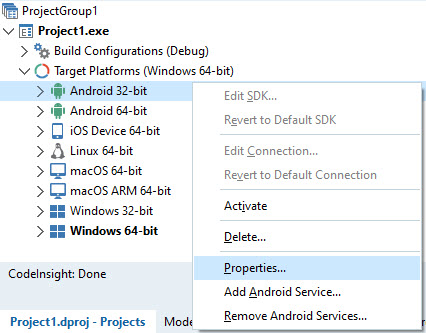
|
2. The Platform Properties dialog box opens:
3. In the SDK (Software Development Kit) drop-down list, do either of the following:
- To use an existing SDK, select the SDK from the list.
- To add a new SDK, click Add New from the list, and follow either the steps for macOS and iOS or the steps for Android.
- Note: The SDK combo box is enabled only for projects that require an SDK. If your project requires an SDK but the SDK combo box list is empty or is missing a specific SDK, see Platform Properties for troubleshooting.
4. In the Profile drop-down list, do either of the following:
- To use an existing connection profile, select the profile from the list.
- To create a connection profile, click Add New from the list and follow the steps in Creating and Testing a Connection Profile on the Development PC.
5. Click OK to save the changes.
Next Steps
- Compile and build as usual.
- Debug using the multi-device debugger.
- Deploy your multi-device application.
